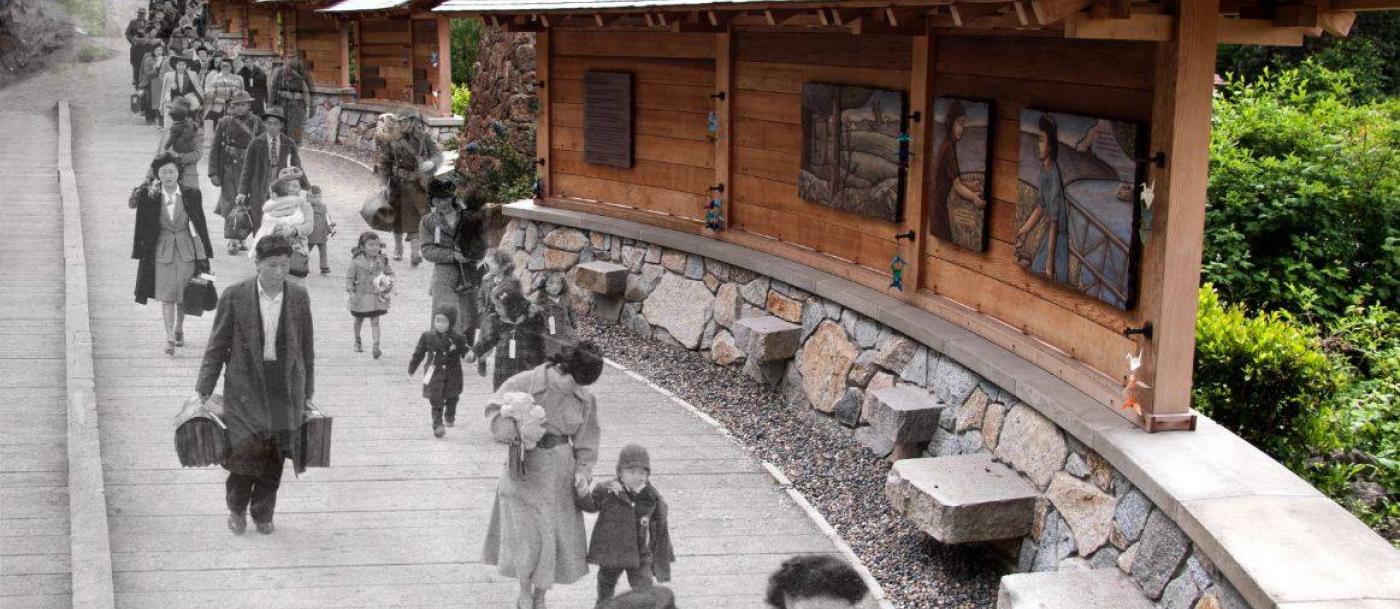Nidoto nai yoni. Let it not happen again.
That’s the idea that Clarence Moriwaki hopes visitors take away from the Bainbridge Island Japanese American Exclusion Memorial. “‘Let it not happen again’ is our message of aspiration and inspiration,” says Moriwaki, president of the Bainbridge Island Japanese American Community. “We want the memorial to stand as proof that in times of fear, citizens can choose to come together and look out for one another, instead of turning against each other.”
The memorial represents the unconstitutional and racist internment of the island’s Japanese and Japanese American residents during World War II. Alongside the heartbreaking history, says Moriwaki, the site—which stands on land Trust for Public Land helped transfer to public ownership in 2005—also celebrates the strength of the tight-knit community that has long called this island home, and the support it showed for its Japanese members throughout their ordeal.

The Bainbridge Island Japanese American Exclusion Memorial stands in a waterfront park that The Trust for Public Land helped create. Photo: Bainbridge Island Japanese American Exclusion Memorial
A Diverse, Tight-Knit Community
Today Bainbridge Island is a bustling commuter town, connected by frequent ferries to downtown Seattle. But in the decades before World War II, Moriwaki says the life on the island was slower and more isolated. Japanese people began moving to Bainbridge during Japan’s economic recession in the 1880s, seeking work in the timber industry alongside people from Croatia, Norway, the Philippines, and Sweden. By the start of World War II, people of Japanese origin made up about 10 percent of the island’s population. Japanese American families worked at the mill, farmed, and operated the island’s hotels, the dry goods store, and everybody’s favorite ice cream parlor. “They were just as much a part of the fabric of this diverse, tight-knit community as anybody,” says Moriwaki.
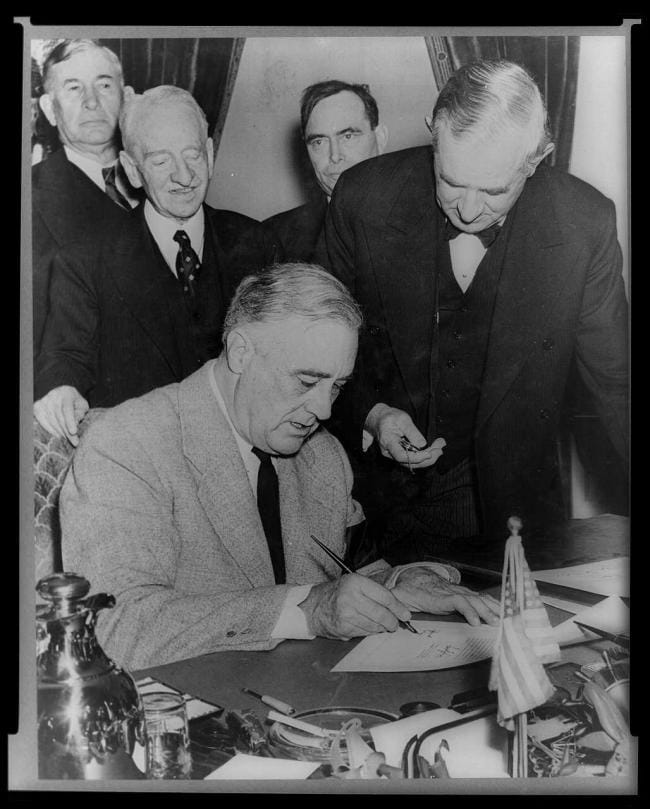
President Roosevelt signing the declaration of war against Germany. Following the attack on Pearl Harbor, the government—and many citizens—began eyeing people of Japanese ancestry with suspicion, fearing that they were acting as enemy spies. Photo: Office of War Information/Library of Congress
But the outside world would soon intrude on the islanders’ way of life. Following the attack on Pearl Harbor, the government—and many citizens—began eyeing people of Japanese ancestry with suspicion, fearing that they were acting as enemy spies. In February 1942, President Franklin Roosevelt codified that suspicion when he issued Executive Order 9066. It authorized the Secretary of War “to prescribe military areas . . . from which any or all persons may be excluded.” In practice, generals defined “military areas” as the western half of Washington, Oregon, and California and the southern half of Arizona, and “persons” as anybody of Japanese origin. (About one-tenth of 1 percent of people with German and Italian ancestry in America were also arrested on suspicion of working for the enemy during the war, while 95 percent of people in America with Japanese ancestry were forcibly detained.) “These orders were racially based, and that’s a fact,” says Moriwaki.
A Community Torn Apart
Bainbridge Island was the first community to suffer the effects. In March, troops arrived with orders to round up every resident of Japanese ancestry. “Residents were given six days’ notice that they were to be removed from their homes,” says Moriwaki. “That was six days to figure out who would look after their farms and shops, what to bring in the one suitcase they were allowed, what to leave behind.” On March 30, 1942, troops loaded 227 people—two-thirds of whom were American citizens by birthright—onto a ferry docked in Eagledale Harbor. It was the first leg in journey that would end in the California desert, at Manzanar War Relocation Center.
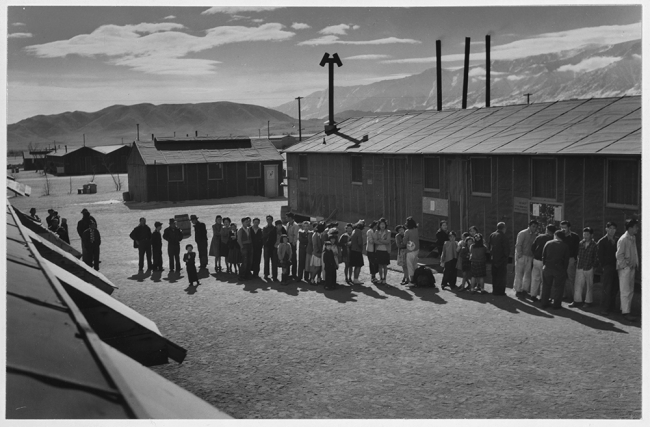
Troops took families from Bainbridge Island to Manzanar Relocation Center, a hastily built camp in the harsh California desert. Photo: Ansel Adams
That spring, the military issued the same orders for every community within so-called Military Area Number 1. Eventually troops forcibly removed 114,000 people from their homes and built 10 concentration camps in remote, desolate areas from California to Idaho to Arkansas to imprison these families. Another 6,000 babies would be born to interned families by the time orders were lifted in 1945.
The government’s actions were “so, so unconstitutional,” says Moriwaki. But just as devastating to many Japanese American families at the time was the fact that their friends and neighbors back home remained silent, or even endorsed the government’s racist and unsubstantiated position that people of Japanese origin posed a unique risk to national security.
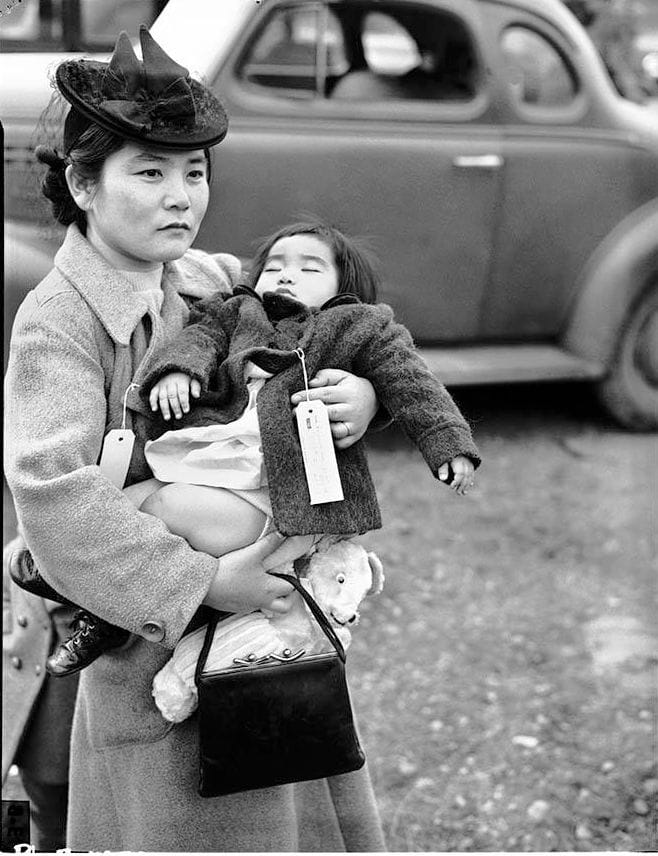
Fumiko Hayashida (1911-2014), holds her sleeping 14-month-old daughter, Natalie, at an assembly point near the ferry dock on Bainbridge Island on March 30, 1942. Photo: MOHAI/Seattle Post-Intelligencer Collection
People of Japanese ancestry did mount a resistance, which went all the way to the Supreme Court in 1944, when a student named Fred Korematsu argued that Executive Order 9066 violated his rights as an American citizen. In Korematsu v. United States, the court ignored the Fourth, Fifth, and Fourteenth Amendments and upheld the order, citing military necessity. Meanwhile, says Moriwaki, “There was not one mass rally trying to stop the military as they rounded up American citizens. There were no demonstrations by white citizens outside any of the camps.”
Bainbridge Island Stands behind Its Japanese Residents
But Bainbridge Island was different, Moriwaki says. Students at Bainbridge Island High School left class and gathered at the dock to say goodbye to their classmates as they boarded the ferry. The Class of 1942 set up 13 empty chairs on stage at graduation that year, holding space for their classmates who were imprisoned. Alone among American newspapers, the Bainbridge Island Review immediately came out against Executive Order 9066 and published a steady stream of pieces protesting the policy. Editor Walt Woodward also kept up a correspondence with islanders who were imprisoned and published the experiences of the island’s Japanese families.
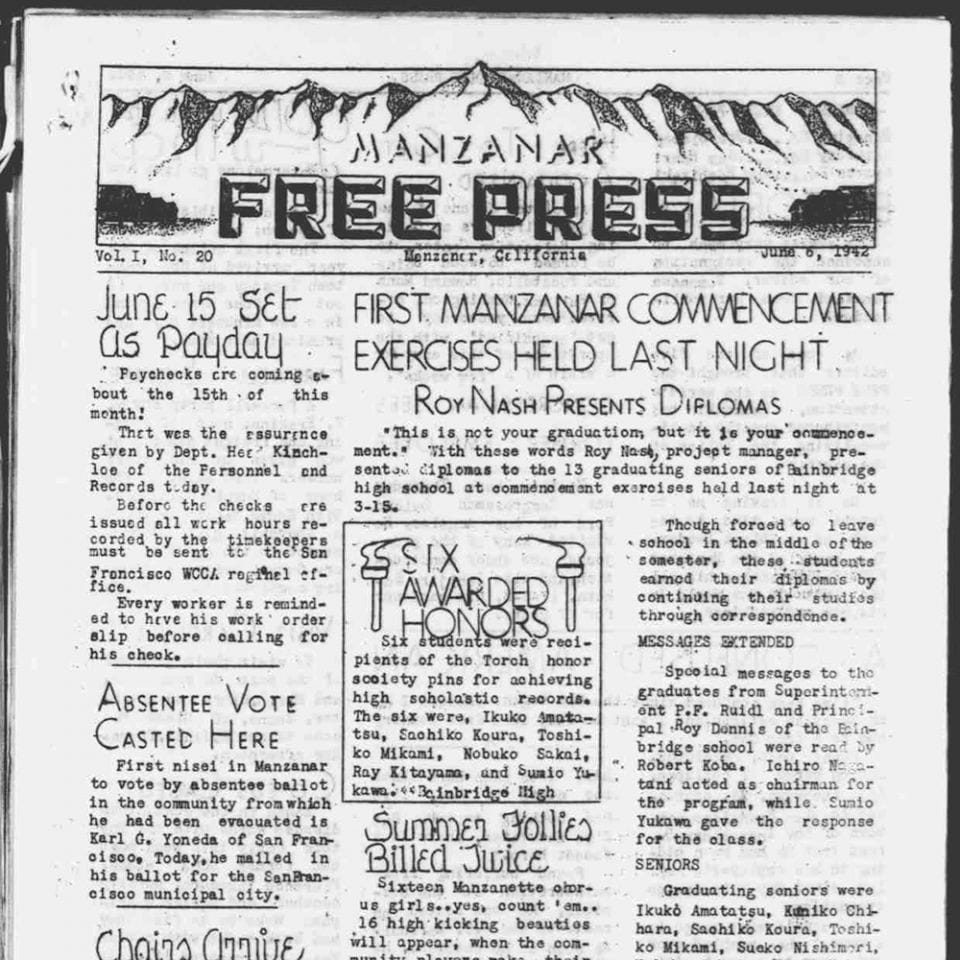
The front page of the Manzanar Free Press on June 6 marked the commencement ceremony for 13 teenagers who would’ve graduated from Bainbridge Island High School. Back home, their classmates left chairs empty on stage to mark their friends’ absence. Photo: Library of Congress
When Roosevelt lifted the exclusion orders in early 1945, Moriwaki says many Japanese American families were met with “incredible hatred and prejudice” from the communities they’d been forcibly removed from three years earlier. Bellingham, Washington, passed a resolution forbidding its Japanese American residents to return. Elsewhere, those who did return had to find new homes and livelihoods. Nationwide, fewer than 15 percent of those who were imprisoned during the war returned to their homes.
“Not on Bainbridge Island,” says Moriwaki. Throughout the war, islanders had looked after their Japanese American neighbors’ property, kept their farms working, and paid taxes, so residents had homes and livelihoods to return to. When the exclusion orders lifted, many islanders reached out to their Japanese American neighbors and asked how soon they’d be able to make it home. Eventually, of the 276 people of Japanese descent who’d been removed from the island in 1942, 150 returned. “The community was ready to welcome them, was waiting for them to be back. So this community got back to speed pretty quickly,” Moriwaki says.
A Long Healing
The damage done by Executive Order 9066 echoed through the decades that followed, as Japanese American families fought to regain their financial and emotional security. The government gradually began to reckon with the harm the policy had caused: President Ford officially rescinded the order in 1976. Carter launched an investigation, and the Reagan administration published the conclusions: “The official federal investigation found zero evidence of disloyalty or sabotage on the part of any person of Japanese ancestry during the war,” says Moriwaki, “And acknowledged that incarceration was based on three things: war hysteria, racial prejudice, and a failure of political leadership.” Reagan issued an official apology to the internees and their descendants, and Congress passed a law in 1988 granting $20,000 payments to survivors.
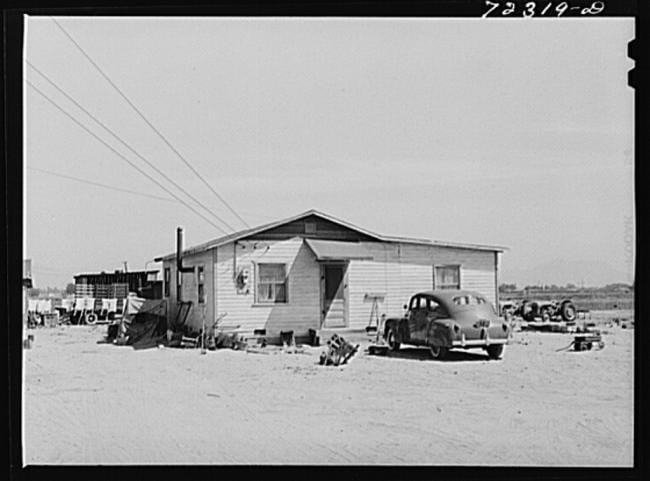
The California farm of a Japanese American family in 1942. As the exclusion orders lifted in 1945, many people who’d been imprisoned learned that little remained of their homes. Just 15 percent of internees returned to their pre-War homes. Photo: Russell Lee
Back on Bainbridge Island, the Eagledale Ferry Dock had long since been demolished. In the early 2000s, Trust for Public Land worked alongside local partners including the City of Bainbridge Island and the Bainbridge Island Japanese American Community to protect the 5 acres where ferry dock once stood and transform it and the surrounding 50 acres of waterfront land into a public park. “If it weren’t for the Trust for Public Land, I don’t know that we could have ever realized this vision,” says Moriwaki. “The organization was absolutely key.”
Since then, the Bainbridge Island Japanese American Community has led the effort to fund, design, and build a place that honors the pain its residents experienced during and after the war—and celebrate the ways that the community rose above the tide of hatred. Today visitors can walk along a wall that holds the names and ages of all 276 people who were taken from the island and read testimonials from both prisoners and their neighbors.
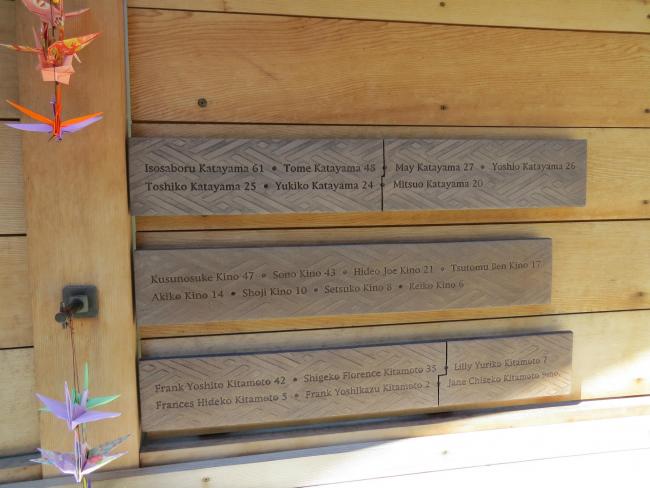
The names and ages of each of the 276 residents of Bainbridge Island who were forcibly removed during WWII appear on the wall of the Bainbridge Island Japanese American Exclusion Memorial. Photo: Bainbridge Island Japanese American Exclusion Memorial
The Bainbridge Island Japanese American Exclusion Memorial has also become a site where the community gathers to show solidarity with other people who are experiencing oppression. Community members—including some who’d endured the internments, and their descendants—held vigils here in 2016 to protest then–President Trump’s ban on immigrants from Muslim nations.
And on March 30, 2021, they came together at the memorial to mark the 79th anniversary of the removal and protest the rise in racist violence and hatred against Asian Americans, including the murders of six people of Asian descent in Atlanta that spring.

Photo: Humanities Washington
Moriwaki (above) draws parallels between current events and those of 79 years ago. “Our message—‘Let it not happen again’—I fear it isn’t being heard. Because it’s happening again, and this time people are dying,” he says.
But he also notes the differences. “I think where I find most hope now is that so many people are speaking up,” he says. Unlike in 1942, “people from all walks of life—from every race, age, nationality—are coming out en masse to show solidarity. I take a lot of strength from that.” And the Japanese Exclusion Memorial plays an important role in remembering the past, but also shaping the future.
“The memorial shows that our community stood by its friends and neighbors,” Moriwaki says. “Our community did not succumb to the tide of fear, and our community built this memorial to serve as a reminder—both of the fearful actions that so many Americans took, and to suggest that there could be a different destiny.”
This raw, beautiful landscape in Southern California is home to Indigenous heritage sites, and it provides critical habitat for threatened and endangered species. Urge President Biden to safeguard this extraordinary landscape today!

Donate to become a member, and you’ll receive a subscription to Land&People magazine, our biannual publication featuring exclusive, inspiring stories about our work connecting everyone to the outdoors.

